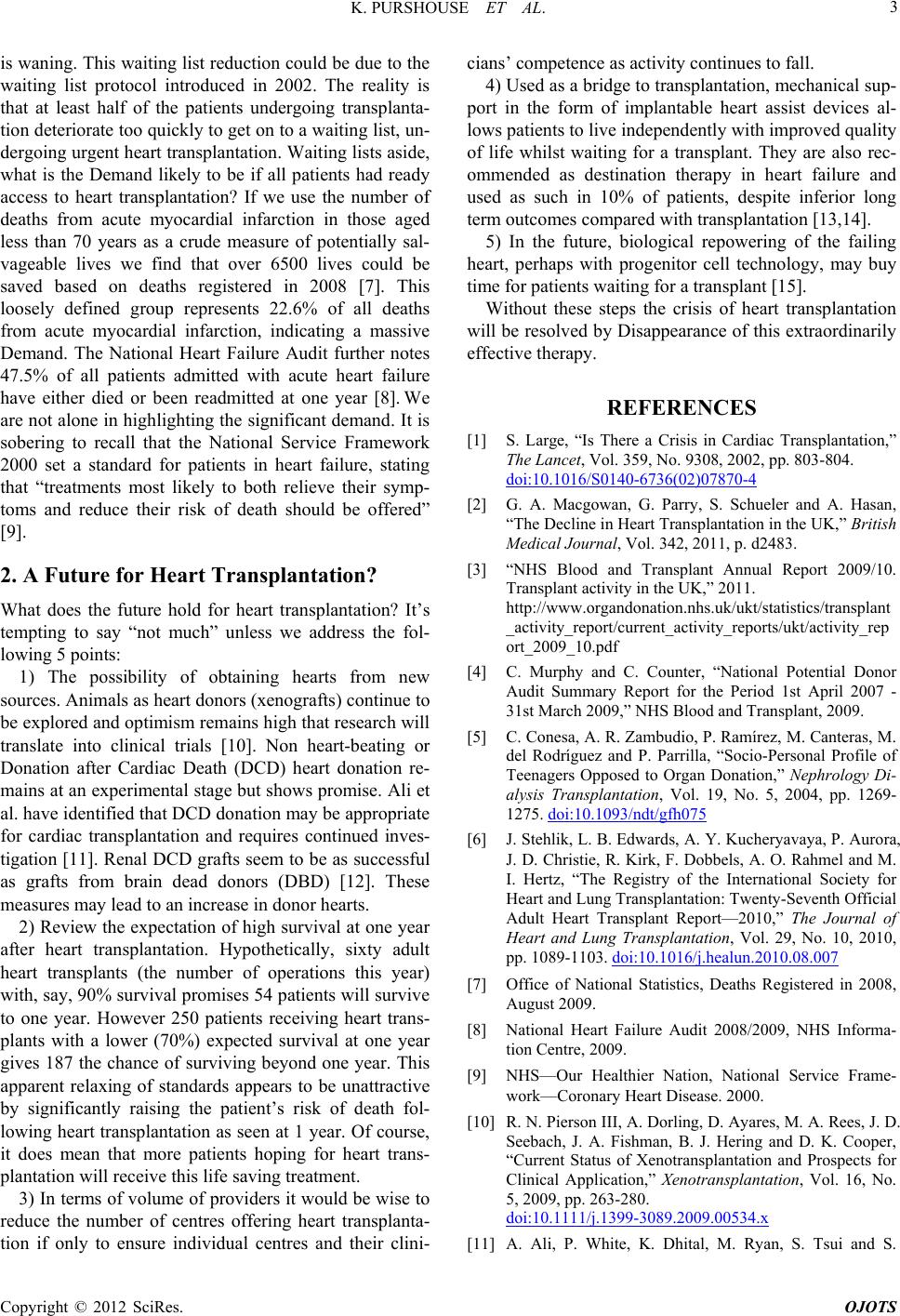
K. PURSHOUSE ET AL. 3
is waning. This waiting list redu ction could be due to the
waiting list protocol introduced in 2002. The reality is
that at least half of the patients undergoing transplanta-
tion deteriorate too quickly to get on to a waiting list, un-
dergoing urgent heart transp lantation. Waiting lists aside,
what is the Demand likely to be if all patients had ready
access to heart transplantation? If we use the number of
deaths from acute myocardial infarction in those aged
less than 70 years as a crude measure of potentially sal-
vageable lives we find that over 6500 lives could be
saved based on deaths registered in 2008 [7]. This
loosely defined group represents 22.6% of all deaths
from acute myocardial infarction, indicating a massive
Demand. The National Heart Failure Audit further notes
47.5% of all patients admitted with acute heart failure
have either died or been readmitted at one year [8]. We
are not alone in highlighting the significant demand. It is
sobering to recall that the National Service Framework
2000 set a standard for patients in heart failure, stating
that “treatments most likely to both relieve their symp-
toms and reduce their risk of death should be offered”
[9].
2. A Future for Heart Transplantation?
What does the future hold for heart transplantation? It’s
tempting to say “not much” unless we address the fol-
lowing 5 points:
1) The possibility of obtaining hearts from new
sources. Animals as heart donors (xenografts) continue to
be explor ed and op timism remains h igh th at research will
translate into clinical trials [10]. Non heart-beating or
Donation after Cardiac Death (DCD) heart donation re-
mains at an experimental stage but shows promise. Ali et
al. have identified that DCD donation may be appropriate
for cardiac transplantation and requires continued inves-
tigation [11]. Renal DCD grafts seem to be as successful
as grafts from brain dead donors (DBD) [12]. These
measures may lead to an increase in donor hearts.
2) Review the expectation of high survival at one year
after heart transplantation. Hypothetically, sixty adult
heart transplants (the number of operations this year)
with, say, 90% survival promises 54 patients will survive
to one year. However 250 patients receiving heart trans-
plants with a lower (70%) expected survival at one year
gives 187 the chance of surviving beyond one year. This
apparent relaxing of standards appears to be unattractive
by significantly raising the patient’s risk of death fol-
lowing heart transplantation as seen at 1 year. Of course,
it does mean that more patients hoping for heart trans-
plantation will receive this life saving treatment.
3) In terms of volume of providers it would be wise to
reduce the number of centres offering heart transplanta-
tion if only to ensure individual centres and their clini-
cians’ competence as activity continues to fall.
4) Used as a bridge to transplantation, mechanical sup-
port in the form of implantable heart assist devices al-
lows patients to live inde pendently with improved quality
of life whilst waiting for a transplant. They are also rec-
ommended as destination therapy in heart failure and
used as such in 10% of patients, despite inferior long
term outcomes compared with transplantation [13,14].
5) In the future, biological repowering of the failing
heart, perhaps with progenitor cell technology, may buy
time for patients waiting for a transplan t [15].
Without these steps the crisis of heart transplantation
will be resolved b y Disappearance of this extraord inarily
effective therapy.
REFERENCES
[1] S. Large, “Is There a Crisis in Cardiac Transplantation,”
The Lancet, Vol. 359, No. 9308, 2002, pp. 803-804.
doi:10.1016/S0140-6736(02)07870-4
[2] G. A. Macgowan, G. Parry, S. Schueler and A. Hasan,
“The Decline in Heart Transplantation in the UK,” British
Medical Journal, Vol. 342, 2011, p. d2483.
[3] “NHS Blood and Transplant Annual Report 2009/10.
Transplant activity in the UK,” 2011.
http://www.organdonation.nhs.uk/ukt/statistics/transplant
_activity_report/current_activity_reports/ukt/activity_rep
ort_2009_10.pdf
[4] C. Murphy and C. Counter, “National Potential Donor
Audit Summary Report for the Period 1st April 2007 -
31st March 2009,” NHS Blood and Transplant, 2009.
[5] C. Conesa, A. R. Zambudio, P. Ramírez, M. Canteras, M.
del Rodríguez and P. Parrilla, “Socio-Personal Profile of
Teenagers Opposed to Organ Donation,” Nephrology Di-
alysis Transplantation, Vol. 19, No. 5, 2004, pp. 1269-
1275. doi:10.1093/ndt/gfh075
[6] J. Stehlik, L. B. Edwards, A. Y. Kucheryavaya, P. Aurora,
J. D. Christie, R. Kirk, F. Dobbels, A. O. Rahmel and M.
I. Hertz, “The Registry of the International Society for
Heart and Lung Transplantation: Twenty-Seventh Official
Adult Heart Transplant Report—2010,” The Journal of
Heart and Lung Transplantation, Vol. 29, No. 10, 2010,
pp. 1089-1103. doi:10.1016/j.healun.2010.08.007
[7] Office of National Statistics, Deaths Registered in 2008,
August 2009.
[8] National Heart Failure Audit 2008/2009, NHS Informa-
tion Centre, 2009.
[9] NHS—Our Healthier Nation, National Service Frame-
work—Coronary Heart Disease. 2000.
[10] R. N. Pierson III, A. Dorling, D. Ayares, M. A. Rees, J. D.
Seebach, J. A. Fishman, B. J. Hering and D. K. Cooper,
“Current Status of Xenotransplantation and Prospects for
Clinical Application,” Xenotransplantation, Vol. 16, No.
5, 2009, pp. 263-280.
doi:10.1111/j.1399-3089.2009.00534.x
[11] A. Ali, P. White, K. Dhital, M. Ryan, S. Tsui and S.
Copyright © 2012 SciRes. OJOTS